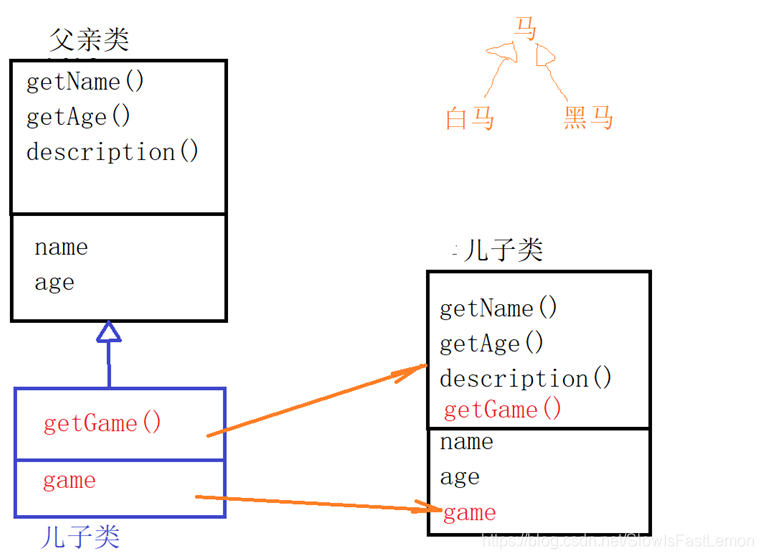1 C++中继承的基本概念
1.1 继承的基本概念
继承关系就是父子关系,UML图如下:

注意是“空心三角箭头”,从子类【派生的类】指向父类【被继承的类】。父类,也称为“基类”。
父亲“派生”出儿子,儿子“继承”自父亲。继承和派生,本质是相同的,只是从不同的角度来描述。
面向对象中的继承指类之间的父子关系:
- 子类拥有父类的所有属性和行为。
- 子类就是一种特殊的父类(子类对象可以直接初始化父类对象,子类对象可以直接赋值给父类对象)。
- 子类对象可以当作父类对象使用。
- 子类中可以添加父类没有的方法和属性。
C++中通过下面的方式描述继承关系:

继承示例代码:
#include <iostream>
#include <string>
using namespace std;
class Parent
{
int mv;
public:
Parent()
{
cout << "Parent()" << endl;
mv = 100;
}
void method()
{
cout << "mv = " << mv << endl;
}
};
class Child : public Parent
{
public:
void hello()
{
cout << "I'm Child calss!" << endl;
}
};
int main()
{
Child c;
c.hello();
c.method();
return 0;
}
1.2 继承的意义
继承是C++中代码复用的重要手段。通过继承,可以获得父类的所有功能,并且可以在子类中重写已有功能,或者添加新功能。
1.3 继承实例分析
继承图如下:

代码如下:
Father.h:
#pragma once
#include <string>
using namespace std;
class Father
{
public:
Father(const char*name, int age);
~Father();
string getName();
int getAge();
string description();
private:
int age;
string name;
};
Father.cpp:
#include "Father.h"
#include <sstream>
#include <iostream>
Father::Father(const char*name, int age)
{
cout << __FUNCTION__ << endl;
this->name = name;
this->age = age;
}
Father::~Father()
{
}
string Father::getName() {
return name;
}
int Father::getAge() {
return age;
}
string Father::description() {
stringstream ret;
ret << "name:" << name << " age:" << age;
return ret.str();
}
Son.h:
#pragma once
#include "Father.h"
class Son : public Father {
public:
Son(const char *name, int age, const char *game);
~Son();
string getGame();
string description();
private:
string game;
};
Son.cpp:
#include "Son.h"
#include <iostream>
#include <sstream>
// 创建Son对象时, 会调用构造函数!
// 会先调用父类的构造函数, 用来初始化从父类继承的数据
// 再调用自己的构造函数, 用来初始化自己定义的数据
Son::Son(const char *name, int age, const char *game) : Father(name, age) {
cout << __FUNCTION__ << endl;
// 没有体现父类的构造函数, 那就会自动调用父类的默认构造函数!!!
this->game = game;
}
Son::~Son() {
}
string Son::getGame() {
return game;
}
string Son::description() {
stringstream ret;
// 子类的成员函数中, 不能访问从父类继承的private成员
ret << "name:" << getName() << " age:" << getAge()
<< " game:" << game;
return ret.str();
}
main.cpp:
#include <iostream>
#include "Father.h"
#include "Son.h"
int main(void) {
Father wjl("王健林", 68);
Son wsc("王思聪", 32, "电竞");
cout << wjl.description() << endl;
// 子类对象调用方法时, 先在自己定义的方法中去寻找, 如果有, 就调用自己定义的方法
// 如果找不到, 就到父类的方法中去找, 如果有, 就调用父类的这个同名方法
// 如果还是找不到, 就是发生错误!
cout << wsc.description() << endl;
system("pause");
return 0;
}
子类, 一般会添加自己的数据成员/成员函数, 或者, 重新定义从父类继承的方法!!! 子类对象就会调用自己重新定义的方法, 不会调用父类的同名方法。
参考资料:
